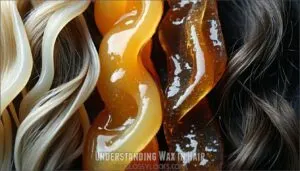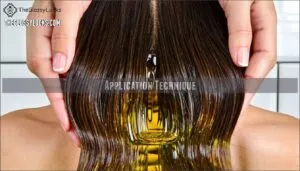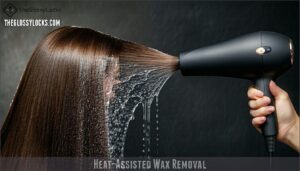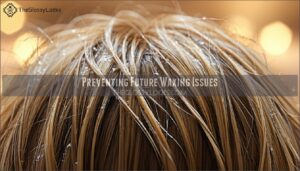This site is supported by our readers. We may earn a commission, at no cost to you, if you purchase through links.
 Getting wax out of your hair might sound tricky, but it’s easier than you think.
Getting wax out of your hair might sound tricky, but it’s easier than you think.
Start by softening the wax with a blow-dryer on low heat or a warm, damp towel—this loosens its grip. Next, massage a small amount of natural oil, like coconut or olive oil, into the waxy strands.
Let it sit for a few minutes, then gently comb through and rinse. Follow up with a clarifying shampoo to remove leftover residue.
Be patient and repeat if needed. With these simple steps, you’ll have wax-free hair in no time. Curious about stubborn cases? There’s more to uncover.
Table Of Contents
- Key Takeaways
- Understanding Wax in Hair
- Initial Steps for Wax Removal
- Oil-Based Wax Removal
- Heat-Assisted Wax Removal
- Mechanical Removal Methods
- Washing Out Wax Residue
- Special Considerations for Stubborn Wax
- Preventing Future Waxing Issues
- Frequently Asked Questions (FAQs)
- How do I get wax out of my hair with oil?
- How to make homemade wax for facial hair removal?
- How do you get candle wax out of your hair?
- How to remove wax stick from hair?
- Can wax be washed out of hair?
- How do you get waxy residue out of hair?
- What dissolves candle wax from hair?
- Can wax removal damage hair or scalp?
- What tools help detect hidden wax spots?
- Are there natural remedies for wax removal?
- Conclusion
Key Takeaways
- Soften the wax with a blow-dryer on low heat or a warm towel, then massage in coconut oil to loosen it.
- Use a wide-toothed comb to gently remove wax, and follow up with a clarifying shampoo to eliminate residue.
- For stubborn wax, repeat the process patiently and try a nourishing hair mask afterward to restore moisture.
- Prevent future issues by applying wax evenly, avoiding your scalp, and sticking to regular maintenance routines.
Understanding Wax in Hair
Wax in your hair creates a sticky situation that can feel impossible to fix, but understanding the type of wax you’re dealing with makes removal much easier.
Wax in your hair may seem like a nightmare, but knowing the type makes removal surprisingly simple and stress-free.
You’ll need different techniques for hair styling products versus candle wax or waxing treatments, so identifying what’s stuck in your strands is the first step to clean, wax-free hair.
Types of Wax
The realm of wax can be confusing when you’re trying to get it out of your hair. Understanding the different types is essential for effective removal.
Soft wax needs strips for removal and works well on legs and arms. Hard wax hardens on its own and is gentler for sensitive areas.
Sugar wax, made from natural ingredients, dissolves easily in water, making it less troublesome if it gets in your hair. Paraffin wax from candles and beeswax can be more challenging to remove due to their sticky consistency.
- Panic sets in when you feel that waxy clump in your freshly washed hair
- Relief comes when you identify the exact wax type for proper removal
- Freedom awaits once you master the right technique for your specific wax situation
Waxing Mistakes
During your waxing session, simple mistakes can lead to frustrating situations. When wax ends up in your hair, don’t panic – you’re not alone!
| Common Mistake | Consequence | Fix |
|---|---|---|
| Overheating Wax | Hair damage | Cool before applying |
| Uneven Application | Patchy results | Use proper technique |
| Wrong Direction | Skin irritation | Follow hair growth pattern |
Double dipping applicators spreads bacteria. To get wax out of hair, try oil-based removal methods immediately. This prevents lasting damage and makes wax removal much easier, reducing the risk of lasting damage and making the process easier with the right technique.
Initial Steps for Wax Removal
Before you remove wax from your hair, you’ll need to assess the type of wax and gather your tools for effective removal.
You should feel through your hair with your fingers to locate all waxy spots and determine whether you’re dealing with soft or hard wax, which will help you choose the most effective removal method.
Assessing Wax Type
Every successful wax removal begins with properly evaluating what type of wax is stuck in your hair. The wax’s composition directly affects which removal method will work best, saving you time and preventing potential hair damage.
First, determine whether you’re dealing with:
- Soft wax (like styling products) that feels pliable and sticky between your fingers
- Hard wax (like candle wax) that has solidified and feels brittle when touched
- Semi-soft wax that has a taffy-like consistency and stretches slightly
Run your fingers through your hair to locate all affected areas. Notice the wax’s color, smell, and texture – these provide clues about its ingredients. Higher-quality wax products typically contain natural ingredients that dissolve more easily.
Check if the wax is mixed with hair strands or sitting on the surface. This wax residue risk assessment helps identify potential hair damage before you begin the actual removal process, which is crucial for a successful wax removal and to prevent further damage.
Preparing for Removal
Now that you’ve identified the type of wax in your hair, it’s time to set up for successful removal. Finding the exact wax location is your first step—run your fingers through your hair from roots to ends or use a mirror for better visibility.
Choose your method selection based on what you’re dealing with: soft wax works well with shampoo, while hard wax responds better to heat or oil treatments.
| Preparation Step | Why It Matters |
|---|---|
| Tool gathering | Having everything ready prevents frustration |
| Drain protection | Prevents expensive plumbing issues |
| Stay calm | Panic makes wax removal harder |
| Cool wax | Let it harden for easier handling |
| Test small area | Guarantees method won’t damage hair |
Don’t forget drain protection—place a paper towel nearby to collect wax pieces instead of letting them go down your sink. For removing residue, consider using baby oil effectively.
Remember, getting wax out of hair doesn’t need to be a disaster. With proper preparation, you’ll be back to normal in no time.
Oil-Based Wax Removal
Oils like coconut, olive, or baby oil break down wax by dissolving its sticky compounds, making removal much easier than other methods.
Coconut, olive, or baby oil melts waxy trouble away, leaving hair smooth and residue-free with minimal effort.
You’ll apply the oil directly to the affected hair, massage it in gently, and wait a few minutes before combing out the loosened wax particles, which makes the process simpler with the help of baby oil.
Choosing The Right Oil
Now that you’ve assessed your waxy situation, it’s time to pick the right oil for the job.
Baby oil, olive oil, and coconut oil work wonders for wax removal, creating a protective barrier while softening stubborn residue.
For sensitive scalps, try jojoba or sweet almond oil.
Tea tree oil helps heal irritations from ingrown hairs and comes in nut-free formulas.
Professional pre/post wax oils offer specialized options like fragrance-free and natural formulations.
You can even find various baby oil products designed for sensitive skin.
Application Technique
Massage the oil into your waxed hair with steady, deliberate movements to break down stubborn residue. Start with a quarter-sized amount, warming it between your palms before application.
For effective wax removal:
- Section your hair carefully, working from the bottom up for even application
- Use your fingertips (not nails) to distribute oil, avoiding direct scalp contact
- Let the oil sit for 5-10 minutes to properly penetrate and dissolve the wax
Don’t rush the process—thorough coverage guarantees the oil can work its magic, making it easier to get wax out of hair.
Heat-Assisted Wax Removal
You can use heat to soften wax, making it easier to remove without damaging your hair.
A blow-dryer or a warm towel works well to melt the wax, so you can wipe it away effectively.
Using a Blow-Dryer
To remove wax from hair with a blow-dryer, start by warming the wax carefully.
Hold the hair dryer at a safe distance, about 6-8 inches away, to avoid heat damage.
Use low to medium heat, moving the dryer in small, steady motions across the waxed sections.
This technique melts the wax gently, making it easier to pull off.
For different hair types, consider various heat settings to prevent damage.
Wrap a section of hair in paper towels to absorb melted wax as you go.
Combine this with the oil from the previous step for smooth results.
This method guarantees effective hair wax removal without risking further mess or damage, and it is a safe and easy way to remove wax.
Applying a Hot Towel
Applying a hot towel is a gentle yet effective way to remove wax from hair.
Here’s how to do it:
- Soak a soft, absorbent towel in hot water, but test the towel temperature to confirm it’s safe for your scalp sensitivity.
- Wrap the towel around the affected area, pressing gently for 2–3 minutes (application duration matters).
- Reheat and reapply as needed to fully soften the wax.
- Follow up with post-treatment care: shampoo thoroughly with a clarifying shampoo, then condition to restore moisture.
A hot towel makes hair wax removal simple and soothing! This process can also open up pores, allowing for better skincare. The use of a hot towel is a gentle method that can be very effective in removing wax from hair, making the overall process simple.
Mechanical Removal Methods
Mechanical methods for removing wax in hair are straightforward and chemical-free. They’re ideal if you want full control during the process.
- Sectioning Hair: Start by dividing hair into small sections. This keeps the process organized and helps you focus on one area at a time.
- Wax Scraping with a Wide-Toothed Comb: Gently comb through waxed areas. A wide-toothed comb is key to minimizing breakage while pulling out clumps.
- Paper Towel Technique: Wrap strands in paper towels and press firmly. The towel’s texture helps grip and lift wax effectively.
For stubborn spots, patience is your best tool. Work slowly, ensuring you’re not tugging or causing discomfort. These practical wax removal tips offer control without the added risks of chemicals.
Professional estheticians also use waxing for longer lasting hair removal. Stay gentle, and your hair will thank you!
Washing Out Wax Residue
Removing wax residue from your hair takes patience, the right products, and proper technique.
Start with shampooing dry hair, then follow up with conditioner to soften and lift any stubborn bits of wax.
Shampooing Techniques
After removing most of the wax, it’s time for a thorough wash. Start with dry hair. Applying shampoo directly, without water, allows it to break down the wax more effectively. Use a clarifying shampoo if possible—it’s specially designed for removing hair wax and product buildup.
Consider using a specialized shampoo formula for best results. Work it through section by section, focusing on areas with the most wax. Rinse with warm water, not scalding hot, as this helps soften and loosen the residue.
Repeat washing if any wax remains. Here’s a quick guide for washing out wax:
| Step | What to Do | Why It Helps |
|---|---|---|
| Shampoo Application | Apply to dry hair | Maximizes wax removal power |
| Water Temperature | Rinse using warm water | Softens wax for easier washing |
| Repeat Washing | Reapply if wax persists | Clears leftover residue |
Finish with a rich conditioner or leave hair product-free for a day to breathe. This step is crucial for maintaining healthy hair after removing wax.
Using Conditioner
Conditioner plays an important role in removing hair wax stuck in your strands. After shampooing, apply a generous amount of conditioner, focusing on areas with residue.
This step provides the necessary slip to loosen stubborn wax while nourishing your hair. For deeper hydration and residue removal, opt for deep conditioning, especially if the wax left your hair feeling dry or tangled.
Time the application to let the conditioner work its magic for a few minutes before rinsing. Fine hair or minimal wax? A leave-in conditioner can offer lightweight residue removal without weighing hair down.
Using conditioner can help to restore essential moisture to the hair after wax removal. Whether deep or leave-in, this step boosts hair manageability, ensuring it feels softer, smoother, and free from leftover wax.
Special Considerations for Stubborn Wax
If the wax in your hair just won’t budge, you may need to repeat the removal process a few times.
For extra care, try using a nourishing hair mask afterward to restore moisture and smoothness.
Repeating The Process
Sometimes, stubborn wax calls for multiple attempts.
If persistent residue remains, refine your technique with careful product reapplication. Whether it’s an oil treatment or shampoo for wax removal, incremental removal is key.
Don’t rush—handle each step gently. Revisit wax removal methods patiently, focusing on areas where hair wax is stuck.
Proper hair washing often resolves what’s left behind, and this patient approach can lead to better results with gentle handling of each step.
When to Use a Hair Mask
After trying various hair wax removal methods, your hair might feel dry or fragile.
That’s when applying a hair mask works wonders. Use it weekly to restore moisture and repair damage.
Choose nutrient-rich ingredients like oils, depending on your hair type and damage level. Let it settle for 10-20 minutes before rinsing.
A good hair mask boosts hair care, soothing strands and loosening stubborn wax remnants naturally. Many people find that natural oils moisturize and help treat hair.
Preventing Future Waxing Issues
Preventing wax mishaps starts with applying the right amount and spreading it evenly, so it’s easier to remove later.
Stick to regular waxing schedules, and you’ll avoid thick build-up and keep your hair manageable.
Proper Wax Application
To avoid sticky situations, start with proper wax application.
- Use the right application tools for even distribution, avoiding your scalp.
- Section hair into manageable parts to control the wax amount applied.
- Make certain hair is clean and dry, skipping oils or lotions.
This simple prep guarantees smoother results and fewer hair wax removal methods later, which is the ultimate goal of a successful wax application to achieve fewer hair wax removal methods.
Regular Waxing Benefits
Sticking to a regular waxing schedule can transform your hair removal routine into a smoother, less stressful experience.
By committing to consistency, you’ll enjoy these benefits:
- Hair Health and Growth Stimulation: Regular waxing encourages finer, slower regrowth, making each session easier while keeping hair follicles healthy.
- Reduced Irritation: Routine waxing minimizes common mistakes, like uneven trimming, which can lead to irritation or wax residue.
- Lasting Smoothness and Skin Exfoliation: Waxing also removes hair but additionally exfoliates, leaving your skin soft and radiant for longer.
With a proper schedule, you’ll avoid unnecessary setbacks, maintain effective wax removal, and maintain smooth, irritation-free skin every time.
Frequently Asked Questions (FAQs)
How do I get wax out of my hair with oil?
Massage a teaspoon of warm coconut or olive oil into the waxy areas of your dry hair.
Let it sit for five minutes, then gently comb out the wax.
Shampoo thoroughly to finish.
How to make homemade wax for facial hair removal?
Ever wonder how to make your own facial hair removal wax?
Combine 2 cups sugar, 1/4 cup lemon juice, and 1/4 cup water.
Heat until golden, cool slightly, then apply thinly for smooth results!
How do you get candle wax out of your hair?
Start by softening the candle wax with a hairdryer on low heat, then apply oil like coconut or olive, massaging it in.
Comb the wax out gently, and wash your hair thoroughly with shampoo.
How to remove wax stick from hair?
Apply a small amount of oil, like coconut or olive oil, to the waxed area, massage gently, and let it sit.
Comb through with a wide-toothed comb, then wash with shampoo and warm water.
Can wax be washed out of hair?
Yes, you can wash wax out of your hair, but it takes a bit of effort.
Use shampoo on dry hair first, rinse with warm water, repeat, and follow up with conditioner to remove residue, which is a complete process to remove wax.
How do you get waxy residue out of hair?
Picture struggling with sticky residue after styling.
Massage conditioner into damp hair, focusing on waxy spots. Rinse with warm water, then shampoo thoroughly.
Repeat as needed. Conditioner softens the wax, making removal easier without damage.
What dissolves candle wax from hair?
Coconut or olive oil works wonders on candle wax in hair.
Massage a small amount into the waxy area, let it sit for a few minutes, then gently comb or wipe out the softened wax.
Can wax removal damage hair or scalp?
Wax removal can damage your hair or scalp if you’re too rough, use excessive heat, or harsh products.
Always stay gentle, use safe methods, and avoid pulling to keep your hair and scalp healthy.
What tools help detect hidden wax spots?
Use your fingers to feel for sticky or stiff areas, sectioning hair as needed.
A handheld mirror or a friend’s help can reveal hidden spots.
Bright lighting also makes wax easier to detect.
Are there natural remedies for wax removal?
Try olive oil, coconut oil, or baby oil to dissolve wax naturally.
Massage it into dry hair, let it sit for five minutes, then gently comb through.
Follow up with shampoo to remove residue completely.
Conclusion
Did you know over 60% of people struggle with removing hair wax at least once?
With these simple methods, you now know how to get wax out of hair quickly and effectively.
Softening the wax, using natural oils, applying heat, and washing thoroughly can make a big difference.
Be patient, repeat steps if needed, and don’t forget a clarifying shampoo for residue.
By following these tips, your hair will be wax-free and back to normal in no time.











